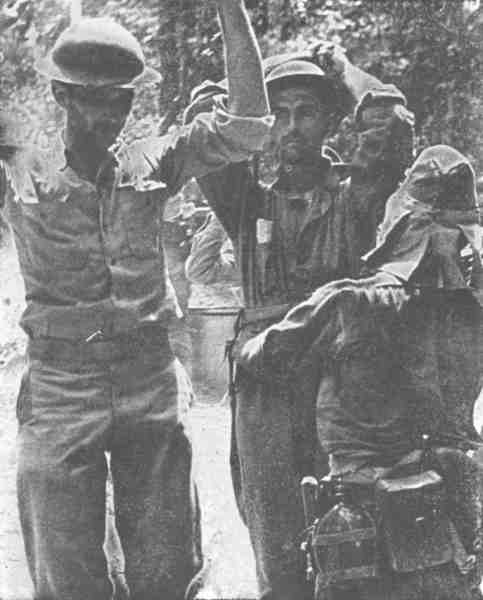The Captors
Thru the valley and shadow of death though I stray,
Since thou art my Guardian, no evil I fear.
—James Montgomery, “The Lord is My Shepherd”
Japan was seeking to establish itself as the dominant force in East Asia. Predictably, these Japanese ambitions were the source of tension and hostility between Japan and the western powers. But there was also another powerful source of hostility: prejudice. The Japanese deeply resented that the western powers, at least in the Japanese view, treated Japan as an inferior country and race. They were similarly offended by the discrimination Japanese frequently encountered in the western countries. The 1924 Immigration Act, which had the effect of excluding Japanese from immigrating to the United States while permitting western European migrations, was especially insulting to Japan.
The Japanese military, a highly nationalistic organization and an influential political force, was particularly strident in its hostility to the United States and its European allies. As part of wartime indoctrination, Japanese soldiers were taught to hate Westerners. And the Americans were now surrendering to this Japanese military.[1]
In the period leading up to the war, there was a strain of ethnic arrogance and racism among many in America with respect to the Japanese. Some Americans had scoffed at the Japanese as people who were neither sufficiently clever nor equipped to withstand a modern Western army.[2] The decisive Japanese military victories had erased these prewar myths. The surrendering soldiers were about to receive some sharp lessons on the nature of this Japanese enemy.
The Japanese Army was not heavily mechanized. Fuel was a scarce commodity. Japanese troops generally traveled long distances on foot, twenty to thirty miles a day. The Japanese Army expected the surrendering American forces to do the same, disregarding General King’s plan to use American vehicles to transport his sick and malnourished troops.[3] In fact, the American soldiers were not used to marching on foot such distances and were too famished and sick to do so in any event—and certainly not at the pace the Japanese demanded. The Japanese seriously misjudged the health and stamina of the Filipino and American forces and the adequacy of their provisions.[4]
In addition, attitudes about military discipline were very different between the opposing armies. Beatings had long been a routine method of discipline in the Japanese Army, and soldiers could essentially strike subordinates at will.[5] The distinction between ranks was of critical importance. It meant the difference between who could inflict blows and who could expect to receive them. This policy of brutality flowed down the ranks to the lowest private. When an enlisted man, hardened by this policy of top-down violence, found himself suddenly thrown into a situation in which he is the superior and in charge of a group of helpless and hated prisoners, the temptation to beat the powerless often became irresistible.
The Japanese soldiers were also unlikely to feel magnanimous toward their American enemy. The Japanese had not conquered Bataan easily. The American and Filipino defense of Bataan had cost the Japanese five months of combat and ten thousand casualties.[6] When Gene Jacobsen, a Latter-day Saint soldier from Montpelier, Idaho, surrendered, an English-speaking Japanese officer told him, “But, on Bataan you have killed many Japanese soldiers, and for that each of you will have to pay.”[7] A few days after the surrender, a Japanese newspaper ran an editorial stating, “To show [the surrendering US forces] mercy is to prolong the war, . . . an eye for an eye, a tooth for a tooth.”[8]
Ironically, however, the greater problem for these Americans in the eyes of the Japanese was not their tenacious defense but that they had surrendered at all. According to the Japanese code of Bushido—the Way of the Warrior—in which the Japanese soldiers had been indoctrinated, the goal of life was death in glorious fealty. Surrender to the enemy was beneath the dignity of a true soldier and a betrayal of his emperor, country, family, and comrades.
Rex Bray, a Latter-day Saint soldier who was wounded in the leg in a firefight with the Japanese and captured a few days later, observed, “For the most part, the Japanese treated me much better than the other prisoners who surrendered. My wound caused my capture. The Japanese did not respect those who surrendered without a fight. They would rather die than surrender.”[9] In the view of their captors, the prisoners were not only hated enemies but also pathetic objects to be despised and loathed.
Soldiers, of course, vary in their competency, temperament, and morality. Soldiers in the Japanese Army were no different. Some were humane and professional in their treatment of the surrendering soldiers, but others were not.[10] Nonetheless, this was war, and the Japanese wanted their best commanders and soldiers on the all-important offensive campaigns, not tending prisoners. Guarding prisoners was not an honorable or coveted duty. Letting this natural selection process run its predictable course, the Japanese Army ended up putting some of its most incompetent, sadistic, and xenophobic soldiers in command of the prisoners.[11]
 American servicemen being searched by Japanese soldiers upon their surrender on Bataan. Courtesy of the United States Navy, Naval History and Heritage Command.
American servicemen being searched by Japanese soldiers upon their surrender on Bataan. Courtesy of the United States Navy, Naval History and Heritage Command.
All these factors came together in a perfect storm of evil for the soldiers surrendering on Bataan. Some of the difficulties they would later face, unfortunately, were not just from their captors. While there were many incidents of great kindness, unwavering support, and personal sacrifice among prisoners, that, sadly, was not always the case. In the deprivations of the prison camp, some would retreat to their most primitive survival instincts, where the jungle rule of “each man for himself” governed.[12] With their surrender, these soldiers fell into a hellish abyss run by a brutal captor with, on occasion, less-than-trustworthy companions.
The brutality began almost immediately. Upon an American soldier’s surrender, the Japanese thoroughly searched him—purportedly for weapons and military intelligence, but the real purpose was simply to loot. Wristwatches seemed to be the favorite, with many Japanese guards strutting around with multiple Timex and Elgin watches on their arms. Parker ballpoint pens, Zippo lighters, and American cigarettes were also popular. For no reason other than malice, guards often shredded pictures of loved ones found on a surrendering soldier. One guard seized a pair of eyeglasses from a prisoner and, after inspecting them, smashed them on the ground with his boot and left the prisoner groping around.
Sometimes the malice was deeper. One guard took a fancy to a prisoner’s gold filling, which, with the smack of a rifle butt to the prisoner’s mouth, became more readily available for his taking. Another guard, growing frustrated trying to remove a coveted West Point ring from an officer’s hand, swollen from beriberi, separated both the ring and the finger from the prisoner with the slice of a machete.[13]
There were innumerable ways an American soldier in the Philippines could end up with a Japanese-made item in his pocket. Japanese logic, however, dictated that a prisoner in possession of any such item—including Japanese currency, Rising Sun flags, or even a small pocket mirror purchased in the United States but made in Japan—must have taken the item from the body of a dead Japanese soldier. This was considered dishonorable behavior with a steep cost, often beheading.[14]
The Japanese guards commonly beheaded prisoners for trivial offenses. As Franklin East put it, “They took you out of the group and you weren’t seen again.”[15] Major William Dyess, who later escaped and wrote an exposé of the Japanese atrocities, wrote that the first murder he observed was the summary beheading of an air force captain by a Japanese private after discovering a few Japanese yen in the officer’s pockets.[16]
For the surrendering POWs, however, these initial searches were just an introduction to the brutality of their imprisonment.
Notes
[1] Holmes, Unjust Enrichment, 8–9; see also Manny Lawton, Some Survived: An Eyewitness Account of the Bataan Death March and the Men Who Lived through It (Chapel Hill, NC: Algonquin Books of Chapel Hill, 1984), 26.
[2] Sides, Ghost Soldiers, 51. Not all soldiers, however, carried this racist view. See text accompanying chapter 2, note 35 regarding Hansen’s experience in Hawaii.
[3] Daws, Prisoners of the Japanese, 73–74.
[4] Sides, Ghost Soldiers, 91–93.
[5] Lukacs, Escape from Davao, 69.
[6] Holmes, Unjust Enrichment, 17.
[7] Jacobsen, We Refused to Die, 91.
[8] Holmes, Unjust Enrichment, 17 (quoting part of an April 14, 1942, editorial in the Japan Times and Advertiser).
[9] Bray, “War Memories,” 14.
[10] The Japanese Navy may have been more humane and professional, at least initially, in its treatment of POWs than the Japanese Army. A POW’s initial treatment upon surrender may have depended on which group he surrendered to. The Japanese Army, however, was responsible for the POW camps. A frustration for the POWs was the unpredictability of their treatment by the Japanese at any particular time. Soldiers surrendering in the southern islands were held for a time at Malabalay in central Mindanao, where they “fared royally” and the Japanese were particularly solicitous of their welfare. Alan McCracken, Very Soon Now, Joe (New York City: Hobson Book Press, 1947), 1–6, 39–45; Lukacs, Escape from Davao, 113.
[11] Sides, Ghost Soldiers, 106; Lukacs, Escape from Davao, 102. See also McCracken, Very Soon Now, 4.
[12] Sneddon, Zero Ward, 35; Daws, Prisoners of the Japanese, 134–35. See also Jacobsen, We Refused to Die, 189, 199 (regarding a cruel, vindictive US commander). Many POW camps, especially in Japan in the later months of the war, included POWs from other Allied countries, such as England, Australia, and the Dutch East Indies, some of whom were Black. The relationships among these Allied groups were usually good, but not always, and sometimes the rivalries undermined unity in the camps and resulted in mistrust and wariness between these groups. See Daws, Prisoners of the Japanese, 23–24, 135–37.
[13] Lukacs, Escape from Davao, 62; Sides, Ghost Soldiers, 82; Cave, Beyond Courage, 166.
[14] Cave, Beyond Courage, 188–89; Shively, Profiles in Survival, 59; Lukacs, Escape from Davao, 61.
[15] East, “Army Life,” 11.
[16] Dyess, Dyess Story, 54–55.
